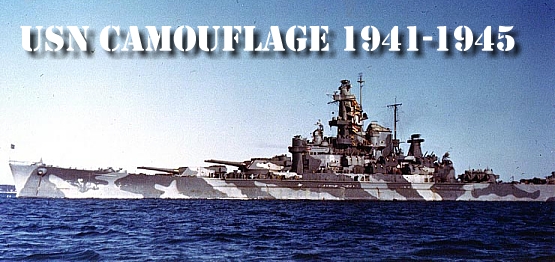
An online database of camouflage used by
United State Naval Warships during WWII
|
|
|
THE
DEVELOPMENT OF NAVAL CAMOUFLAGE 1914-1945 9.)
That under flares and star shell, ships are extremely likely to be sighted
however they are painted: the use of dark toned camouflage to allow for flares
is seldom justifiable. 10.)
That ”dangerous” moonlit hours occupy only a small portion of the total dark
hours throughout a year. (”dangerous” implying that light tones will be
conspicuous). 11.)
That U.S. ”Light Gray” (Which is approximately equivalent to British G.45)
is the tone which shows the best ”all around the clock” performance. 12.)
That ships are very much more often sighted because they are darker that their
background, than because they are lighter. 13.)
That masts should be white. 14.)
That the most useful camouflage for Battleships as that which will give them
protection against ”snooper” aircraft at very long range. (It is however NOT
agreed that Type deception will do so effectively). 15.)
That a pattern of tones about 20% and 50%
reflectance will be effective for reducing a ship’s visibility in twilight and
low meteorological visibility. (Admiralty standard scheme A was largely designed
with an view to such conditions. It is considered that the darker tone should
not be applied in the upper works). 16.)
That the term ”conspicuous” is often reserved for ships which are lighter
than their background, while ships which are darker but in much greater
contrast, are not objected to. 17.)
That shore backgrounds may be very light in tone. 18.)
That aircraft carriers are less susceptible of camouflage (for any object) than
other ships, because of the line of the flight deck which is emphasized by the
ineradicable shadows below it. 19.)
That the low visibility schemes recommended for carriers are likely to be as
effective as any (though possibly stronger counter shading might help them;
Admiralty standard scheme A is similar in general but probably somewhat lighter
in tone). 20.)
That patterns on deck areas are of no use. 21.)
That the color of paints is relatively unimportant; whereas the tone is of great
importance; and that bluish greys are on the whole the most useful colors. The
two navies conclusions were the result of four continuous years of global use
and observation, and would almost certainly hold up under further examination One
factor that can often play a part in any camouflage effectiveness is the belief,
or disbelief, of the human observer. If a person believes in the camouflage that
his ship is wearing, it can only help morale. Surely this is a good thing, even
if impossible to measure accurately. And the opposite applies if someone thinks
that the camouflage can only help the enemy. In the Royal Navy, where captains
sometime believed the latter, it could result in a quick change of paintwork.
For example, the captain of the destroyer VENESSA had to have his ship painted
in the very pale tones of Western Approaches camouflage. While in this scheme
she formed part of the escort for an East bound convoy, and was unfortunate
enough to sustain several night bombing attacks from German aircraft. The
captain, convinced that it was the large areas of white that had made the vessel
stand out to the enemy, had the ship painted back to overall dark grey after
only a few days in Western Approaches camouflage. Admiral
Barnett (RN) always liked to have his ships in overall dark grey just so he
could see them more easily, regardless of any negative or positive effect upon
the enemy. Captain
Todd (USN) said of dazzle camouflage in 1944, ”confusing as hell”, which was
a positive comment. The
commander of Destroyer Squadron 47 (USN) had a negative view, believing that no
matter what type of camouflage was used, it had absolutely no effect whatsoever.
Captain
Mountbatten (RN) who had developed and promoted the use of his singular one
color camouflage in both navies had unshakable faith in its effectiveness.
However the Admiralty deferred any endorsement, mainly because of the almost
complete lack of reports one way or the other. Mountbatten Pink was one of those
schemes that either one had blind faith in, or a complete lack of interest.
However, there seemed to be almost no body of opinion that was really against
it. The
captain of the cruiser NORFOLK. upon taking command soon after the BISMARCK
action, noticed that her wood decks were painted a dark blue as an aid to
concealment from the air. As soon as possible he had the crew set to, scraping
of the color to restore the light bleached natural wood color. He noted in a
letter ”a much smarter appearance”. What matter any possible aid to
concealment when ”smartness” seemed to matter more. This attitude, which
during the early war period sometimes showed itself, had virtually vanished as
the war moved on. In
recent years one could argue that electronic methods of detection,
identification, and tracking have made all painted camouflage totally obsolete.
However, in any combat situation at sea, there are occasions when all radars and
other sensors are shut down to avoid giving out an electronic signature. Will
seagoing camouflage ever re-appear in the major navies? There is no way of
knowing, but there is a growing trend toward the use of optical instruments for
identification and tracking, as more and more, radar and other electronic
sensors are shut down to avoid announcing their presence and location. This
could mean that painted camouflage may once again be abroad at sea. EPILOGUE
|